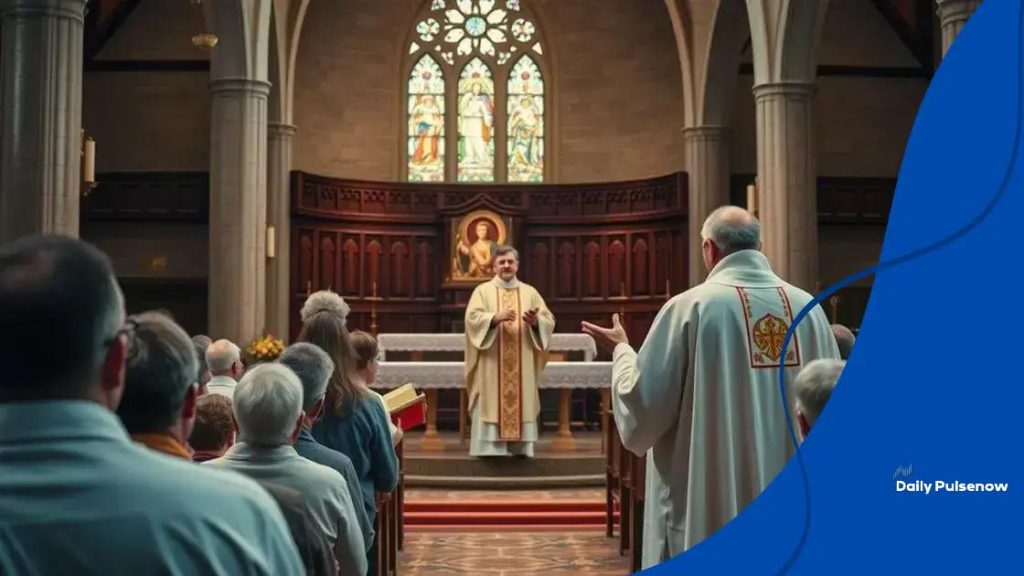Catholic Church appoints new leadership amid changing times

Anúncios
The Catholic Church’s new leadership aims to enhance community engagement, modernize outreach, and address social issues, while navigating challenges of tradition and varying responses among its diverse communities.
The Catholic Church appoints new leadership to navigate the complexities of today’s world. This significant change holds the potential to reshape the Church’s role in society and its engagement with followers. Are you curious about how this leadership shift might affect your community?
Anúncios
Understanding the new leadership structure
Understanding the new leadership structure of the Catholic Church is essential for followers and communities alike. This restructuring brings forth changes that may impact how the Church interacts with its members and the wider world.
The Changes in Leadership Roles
As the Catholic Church evolves, it’s crucial to recognize the different roles emerging within the leadership. The new appointments reflect a desire for modern leadership that resonates with today’s challenges. This change signifies a shift towards greater inclusivity.
Key Leadership Positions Explained
Here are some key roles in the revised structure:
Anúncios
- Pope: The central figure and spiritual leader of the Church, guiding overall doctrine.
- Cardinals: Senior church officials who advise the Pope and oversee regions.
- Bishops: Responsible for local churches and ensuring that the Church’s mission is fulfilled in their areas.
- Clergy: The priests and deacons who carry out community-focused work.
This clear hierarchy illustrates how roles are defined within the Church. Each level has unique responsibilities that contribute to the leadership’s overall effectiveness. Better communication between these roles is anticipated, fostering improved relationships among communities.
Moreover, lay leadership is gaining importance, allowing congregations to engage actively in decision-making processes. This inclusion may lead to more relatable and effective leadership, appealing to younger generations.
Impact on the Faithful
The new leadership structure aims to bridge gaps between the Church and its followers. As new leaders take on their roles, their approach to social issues may reflect contemporary values. This could help create a more welcoming environment within the Catholic Church.
Key figures in the new leadership
Exploring the key figures in the new leadership of the Catholic Church provides insights into how the Church will navigate its future. Understanding these leaders and their roles is vital for members and interested observers alike.
The Pope’s Vision
The Pope remains the central figure within the Church, offering spiritual guidance and setting the overall direction. His vision often emphasizes outreach and modernization, aiming to engage with the faithful more effectively.
Notable Cardinals
Several cardinals have risen to prominence in recent times. Here are key figures:
- Cardinal A: Known for his work on social justice.
- Cardinal B: Focuses on youth engagement and community service.
- Cardinal C: Advocates for interfaith dialogue and understanding.
These cardinals play crucial roles in advising the Pope and managing regions. Their influence extends to various initiatives that connect the Church with local communities.
Another essential leader is the head of the bishops, who oversees local leaders. This role ensures that the message of the Church is consistent and clear throughout different regions. The collaboration of these figures is important in facing contemporary issues.
Alongside bishops, the involvement of lay leaders is increasing. Laypeople are becoming more involved in decision-making, allowing for a wider array of perspectives and greater connection with the congregation. This shift in leadership dynamics is promising for the Church’s relevance in the modern world.
Impact of Leadership Changes
With these key figures in place, the Catholic Church may create a more approachable image. Leaders are expected to navigate the challenges of modernity while remaining true to the Church’s core values.
Impacts on community engagement and outreach

The impacts of the new leadership in the Catholic Church on community engagement and outreach are significant. These changes aim to strengthen the Church’s connection with local and global communities.
Enhanced Community Programs
One of the main focuses of the new leadership is to enhance community programs that directly benefit the congregation. These initiatives can include:
- Food drives: Providing meals for those in need.
- Educational workshops: Offering classes on financial literacy and parenting.
- Health services: Organizing health fairs to promote well-being and awareness.
By prioritizing these programs, the Church seeks to address real needs in the community, making a tangible impact on people’s lives.
Moreover, outreach efforts will be more strategic. The leaders believe that better communication channels will allow the Church to reach a wider audience. They plan to use social media and community events as platforms for sharing messages of hope and guidance.
Building Relationships with Youth
Another important aspect is the engagement of young people. The new leadership recognizes that today’s youth face unique challenges. The Church aims to connect with them through relevant programming and events. These may include:
- Youth retreats: Offering spiritual and bonding experiences.
- Service projects: Encouraging young people to give back to their communities.
- Mentorship programs: Pairing youth with positive role models in the Church.
By fostering these relationships, the Church hopes to cultivate a new generation of engaged and active members.
The impacts of this leadership shift extend beyond the local community. The Church aims to enhance its global outreach as well, participating in international campaigns to promote social justice and support humanitarian efforts. This global perspective can inspire local actions and create a network of support that transcends borders.
Responses from different Catholic communities
The responses from different Catholic communities to the new leadership are diverse and reflect a wide range of perspectives. As the Church shifts its leadership structure, communities are expressing their thoughts and feelings on what these changes mean for their faith.
Supportive Reactions
Many communities welcome the new leadership eagerly, seeing it as a chance for renewal. They believe this change can bring fresh ideas and a more modern approach to Church teachings. Supporters often emphasize:
- Hope for inclusivity: Many expect the new leaders to create a more welcoming environment.
- Focus on youth: There’s a strong desire for initiatives aimed at engaging younger members.
- Community involvement: Communities hope for increased outreach efforts that connect them better with local needs.
This optimistic outlook is bolstered by the new leaders’ promises to emphasize these values in their governance.
Concerns and Criticisms
However, not all responses are positive. Some communities express concern about the changes, fearing that it may alter traditional practices. Various issues arise, including:
- Loss of tradition: Certain members worry that new ideas might dilute established teachings.
- Communication gaps: Some argue that not all communities may be adequately informed about the changes.
- Potential division: There’s fear that differing responses could lead to fragmentation within the Church.
These concerns highlight the importance of open dialogue between leaders and community members to ensure that traditional values are respected while embracing progress.
Many communities also hope for greater transparency from the leadership. Understanding the reasoning behind decisions can help reduce misunderstandings. Engaging with local groups can foster a sense of unity, allowing for a smoother transition as the Church adapts to the new leadership model.
Future challenges and opportunities for the Church
The future challenges and opportunities for the Catholic Church are closely tied to the recent leadership changes. As the Church seeks to adapt to a rapidly changing world, understanding these dynamics is essential for the community.
Adapting to Modern Society
One of the biggest challenges facing the Church is the need to remain relevant in today’s society. Many young people feel disconnected from traditional practices, leading to declining attendance. To address this, the Church has the opportunity to:
- Embrace technology: Using social media and online platforms can help engage younger generations.
- Offer flexible services: Making Mass times more convenient can attract more attendees.
- Promote community involvement: Encouraging members to take part in local initiatives can foster a sense of belonging.
This willingness to adapt could bridge the gap between the Church and the modern world.
Addressing Social Issues
Another significant challenge is addressing pressing social issues such as poverty, inequality, and environmental concerns. The Church has a chance to take a leading role in advocating for change. By actively participating in social justice initiatives, the Church can:
- Provide support to marginalized communities: Outreach programs can directly assist those in need.
- Engage in ecological initiatives: Promoting sustainability aligns with many members’ values.
- Foster interfaith dialogue: Collaborating with other faiths to address common challenges can strengthen community bonds.
These efforts can enhance the Church’s image as a compassionate and proactive institution, dedicated to making a difference.
It’s also essential that the Church prepares for potential divisions within its ranks. As communities respond differently to leadership changes, fostering unity will be crucial. Leaders must prioritize open communication and inclusivity to keep the Church cohesive.
Seizing Opportunities for Growth
While challenges abound, so too do opportunities for growth. A renewed commitment to outreach and community engagement can revitalize the Church. New programs focused on youth involvement can increase participation and ensure the Church remains vibrant. Working together, communities can navigate these challenges and harness the full potential of the Church’s mission.
FAQ – Questions About the New Leadership in the Catholic Church
What are the main changes in the Catholic Church’s leadership?
The main changes include the appointment of new cardinals and bishops who aim to modernize the Church and enhance community engagement.
How will the new leadership affect youth engagement?
The new leadership is focused on creating programs that specifically target youth to help them feel more connected to the Church.
What challenges does the Church face with this leadership change?
The Church faces challenges such as maintaining tradition while adapting to modern societal values and addressing differing responses among communities.
How can communities get involved with the new leadership?
Communities can participate by engaging in outreach programs, attending meetings, and sharing their thoughts with Church leaders to ensure their voices are heard.